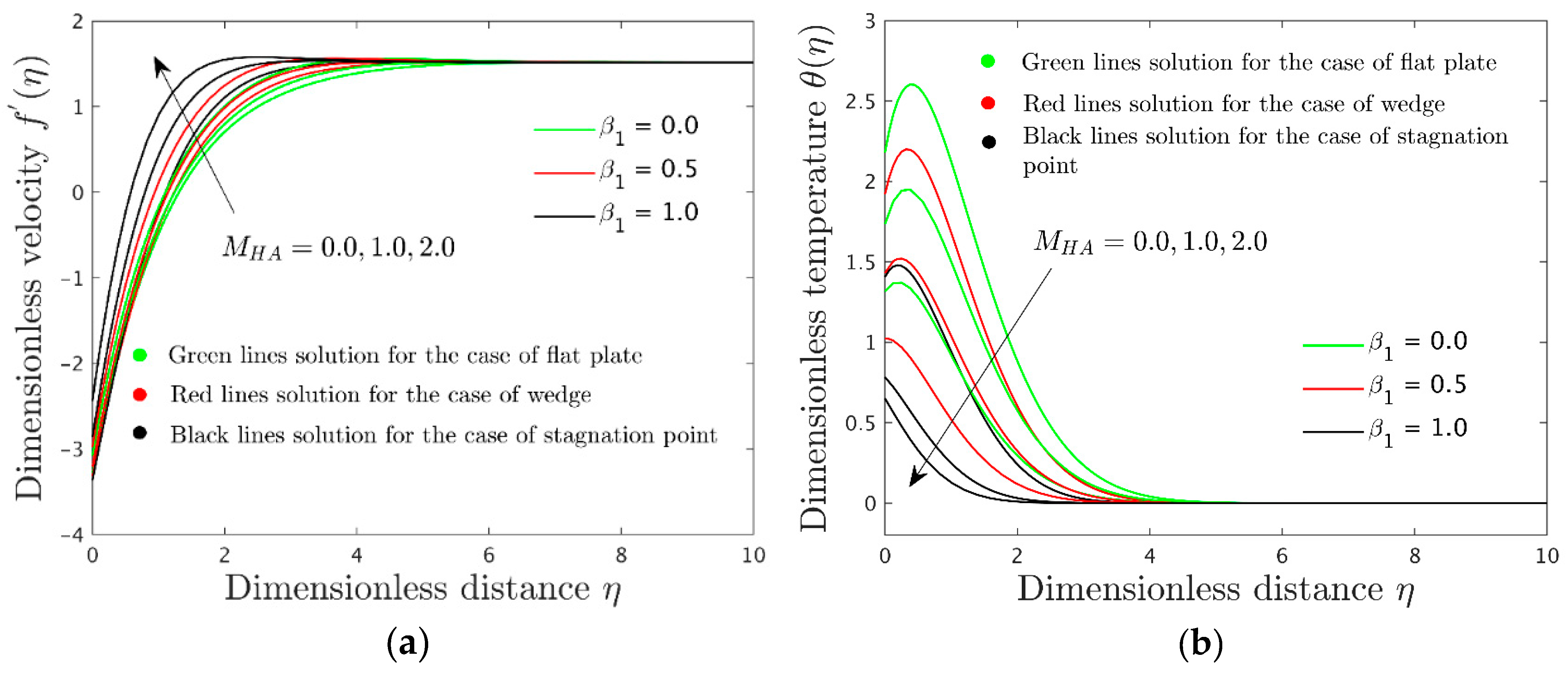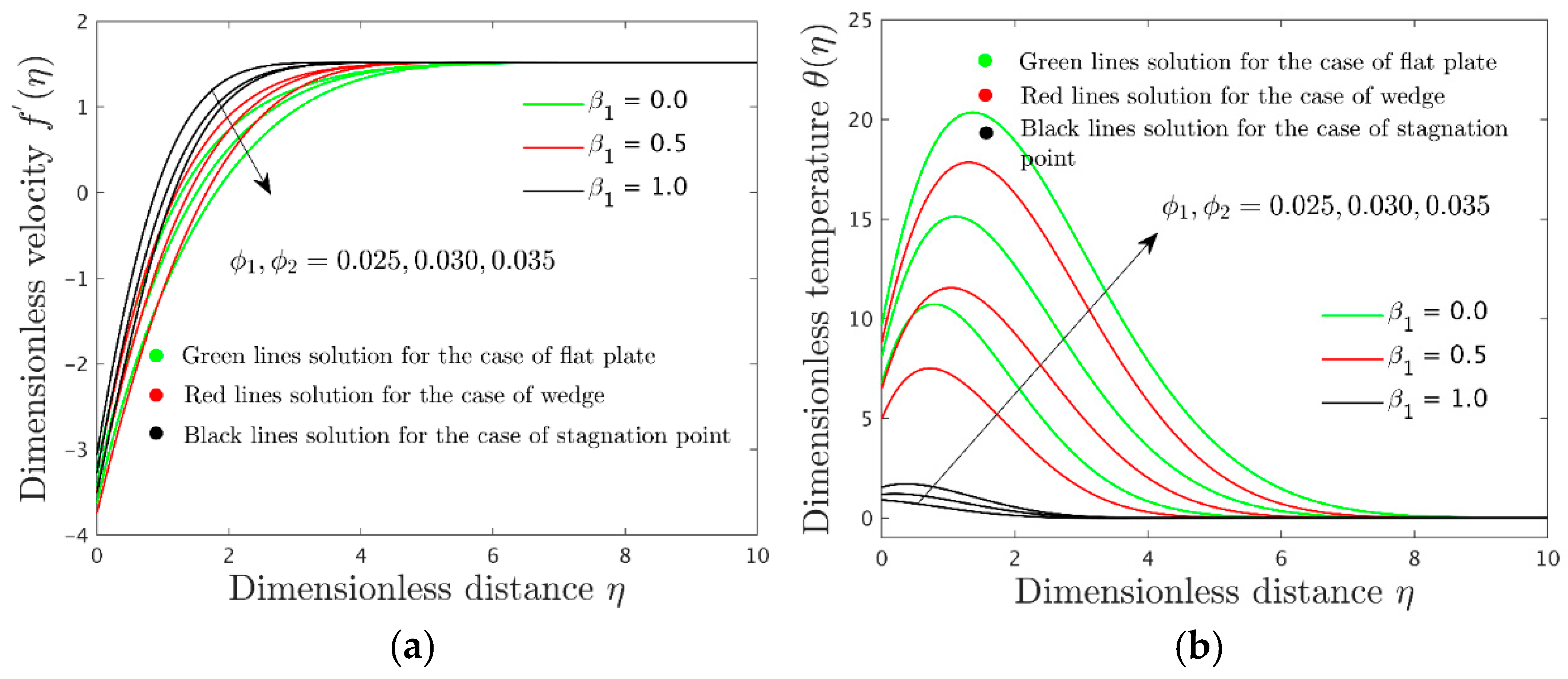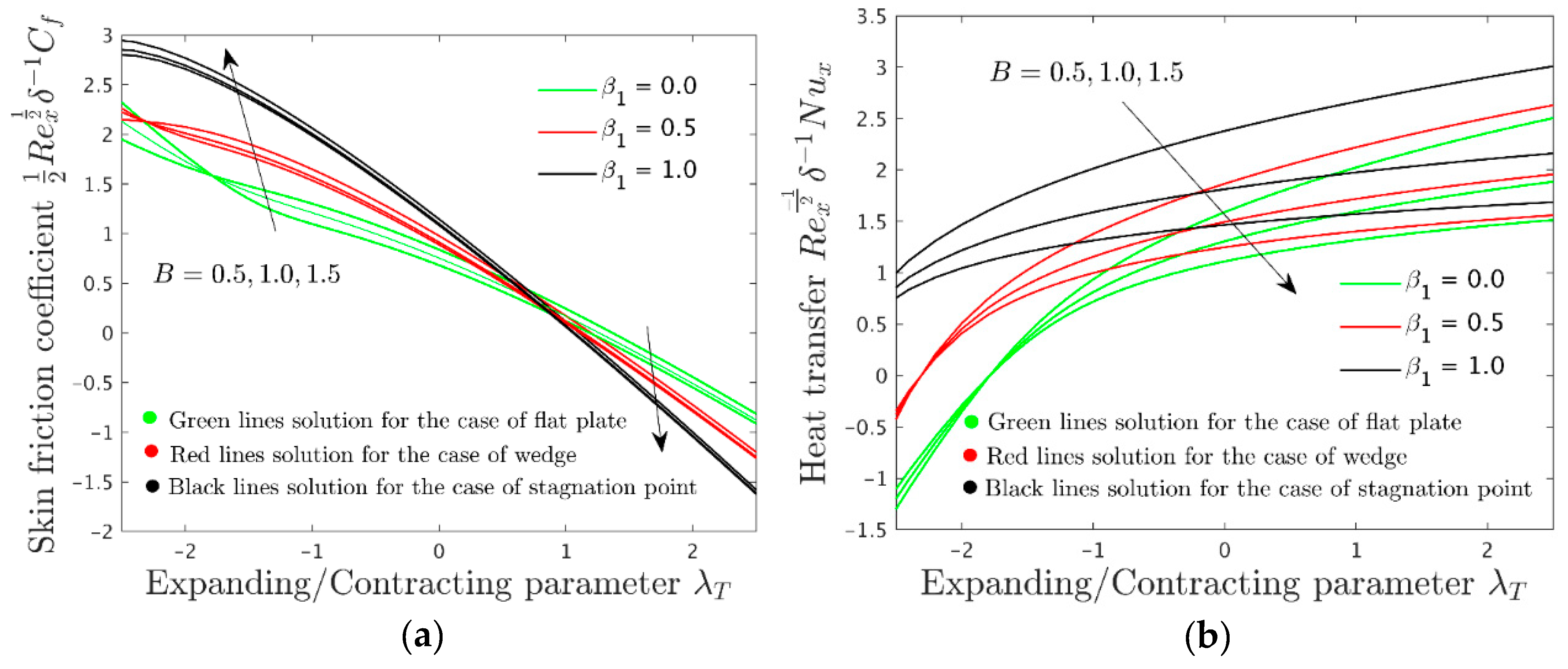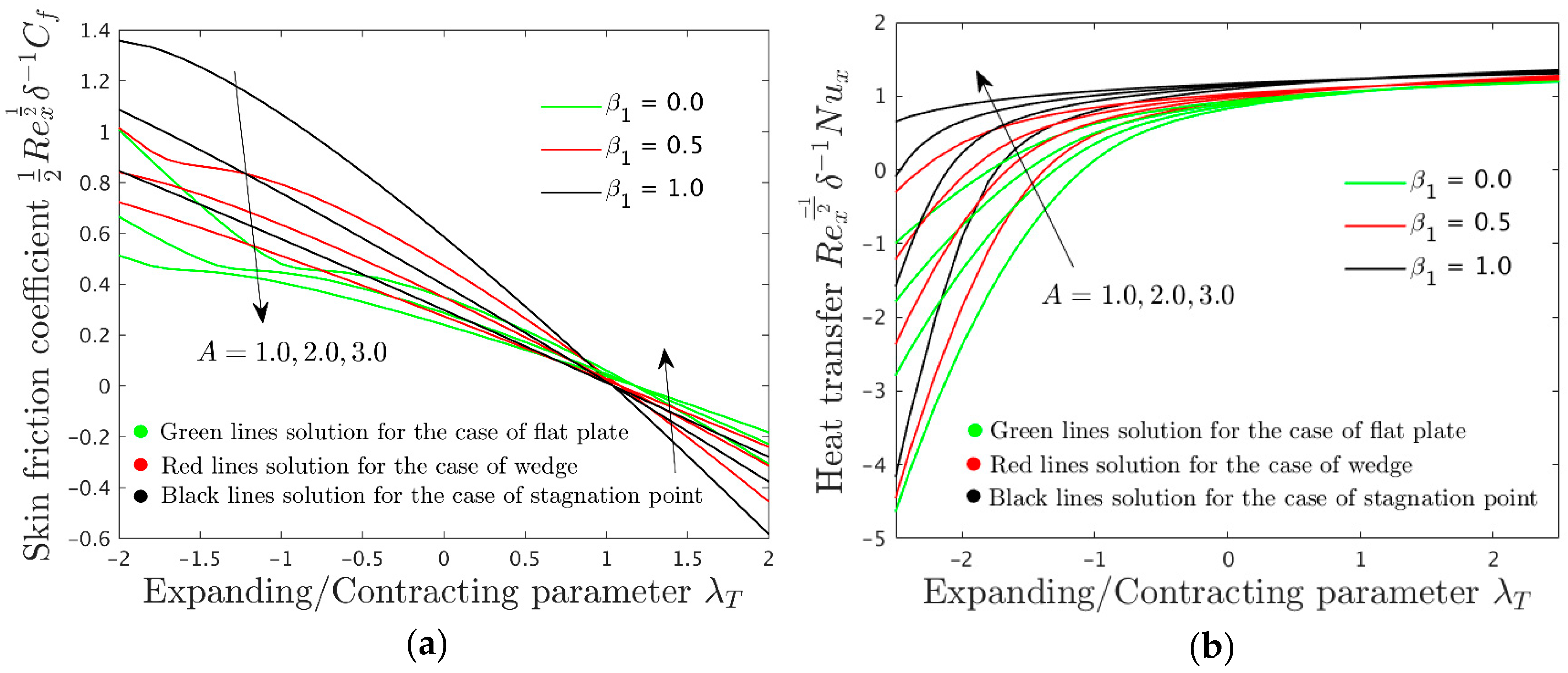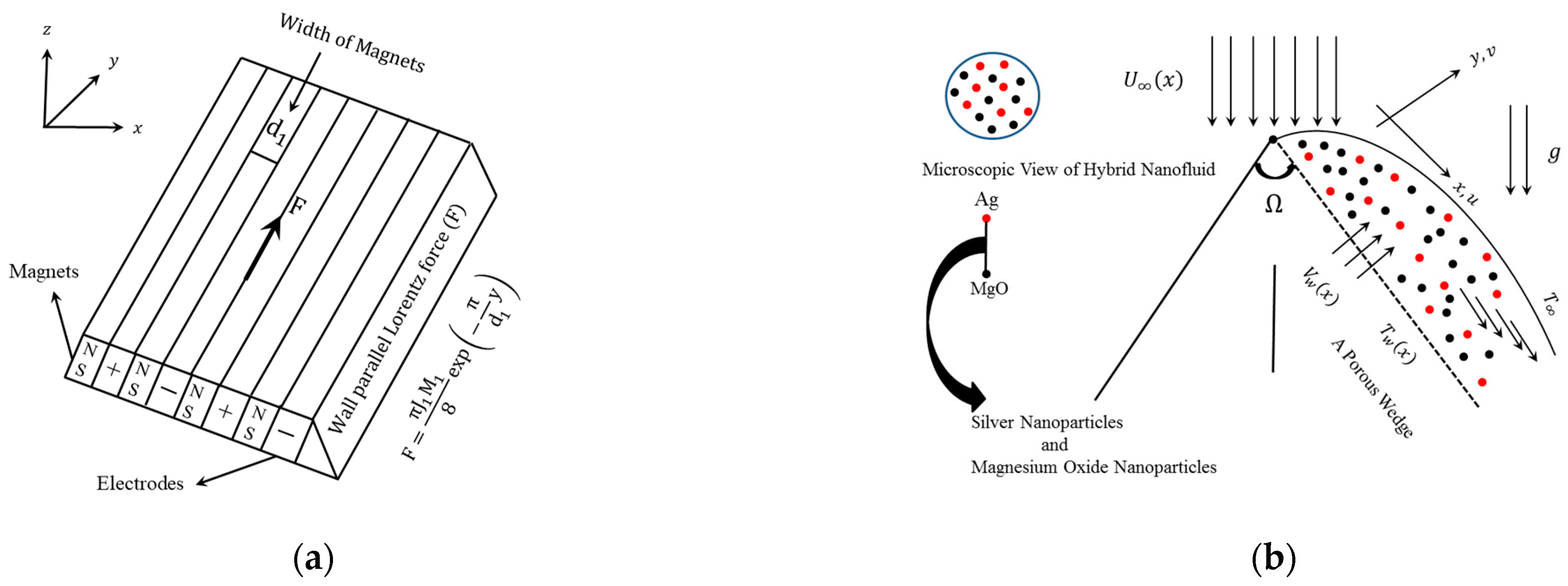1. Introduction
Technologies in modern science identify the significant role of a new kind of fluids in heat transfer due to uplifting requirements of energy and are signified as Nanofluid. The thermal conductivity of regular fluids is vital in the mechanism of heat transfer features. As the materials of non-metallic such as ethylene, glycol, oil, and water have less thermal conductivity compared to materials of metallic such as aluminum, silver, diamond, gold, copper, etc. To boost the thermal conductivity of these regular fluids, the oxides and metallic materials are scattered into these fluids. The selection of a combination of regular fluid particles depends on applications for which the nanofluids are deliberated. They have numerous applications in biomedical and engineering such as the cooling process in industries, cancer therapy, etc. Choi figure [
1] proposed the word nanofluid by comprising the tiny particles of size 1–100 nm into the regular fluids. Gorla et al. [
2] inspected the heat transport fluids containing nanofluid through a circular cylinder in a stretching motion. Similar research has been carried out by Fakour [
3] by considering the fluid flow in a porous channel with a magnetic field. Makinde and Aziz [
4] examined numerically the fluid flow from a heated stretched surface induced by nanofluid with the aid of the RK technique. Akber et al. [
5] scrutinized the magnetic flow involving nanofluid incorporated the Brownian motion in peristalsis. The bi-phase couple stress flow of nanofluid was numerically inspected by Zeeshan et al. [
6]. Recently, Khan et al. [
7] discussed the impact of entropy on the nonlinear radiative flow of ethylene-glycol and water-based gamma-Al
2O
3 particles through a vertical stretched surface with mixed convection and viscous dissipation. The features of heat transport and entropy impact induced by a non-Newtonian nanofluid past an expandable linearly irregular medium are investigated by Jamshed et al. [
8]. Jamshed et al. [
9] inspected the thermal characteristics of Casson fluid containing nanoparticles through a parabolic solar trough collector. They scrutinized that the thermal efficiency enhances up to 18.5% in the presence of nanofluid. Some recent developments on the performance of nanofluid in the heat transfer enhancement are summarized in refs. [
10,
11,
12].
Recently, to enhance the heat transfer properties, scientists and researchers are mixing two or more nanoparticles into the regular fluid to achieve superior thermal conductivity namely called hybrid nanofluid (HyNF). To generate a HyNF, a two-step technique is widely utilized by scholars and researchers due to its capability and the cost of effectiveness on a large usual scale. Turcu et al. [
13] were the first anticipate the synthesis of the Fe
2O
3/MWCNTs hybrid nanofluid. The different features and techniques containing hybrid nanofluid were examined by Nine et al. [
14]. Huang et al. [
15] scrutinized the heat transport features and nanofluids’ pressure drop involving Al
2O
3/MWCNTs hybrid nanofluid. The impact of nonlinear radiation on the 3D rotated flow of Cu-Al
2O
3 hybrid nanocomposites past a stretched surface with unsteady thermal conductivity was scrutinized by Usman et al. [
16]. Waini et al. [
17] surveyed the time-dependent flow with characteristics of heat transport over a continuous porous shrinkable/stretchable curved sheet induced by a hybrid nanofluid and multiple solutions were found by using the bvp4c technique.
The significant features of the magnetic field are found in several fields such as geophysics, astrophysics, flow meters, MHD generators, thermal nuclear reactor, etc. The extensively utilized fluids as liquid metals, electrolytes, plasma, and several others depending on the application of electric and magnetic fields. The liquids are not consistently good electricity conductors, even though their conductivity can be uplifted by employing an electric field via an external agent. Alternatively, the Riga plate is an electro-magnetic actuator containing electrodes and magnet pairs displayed in a specific form that was initiated by Gailitis and Lielausis [
18]. Pantokratoras and Magyari [
19] involvedlow electrical conductivity to inspect the fluid flow through a Riga surface. Hayat et al. [
20] examined the erratic thick Riga surface contained in the fluid flow of nanofluid affected via heat generation/absorption properties. Ahmad et al. [
21] explored the impact of zero mass flux and convective heating on flow moving through a Riga plate with nanofluid. The bvp4c and shooting techniques were employed to acquire the numerical results. The bio-convection influence of nanofluid from an erratic thick Riga surface within the domain flow was investigated by Iqbal et al. [
22]. Ganesh et al. [
23] explored the electro-magneto flow of nanofluid containing gamma aluminum particles from a Riga stretchable plate. Zaib et al. [
24] obtain multiple solutions of the radiative flow of micropolar fluid involving alloy particles through a Riga surface with buoyancy influences. Recently, Khatun et al. [
25] investigated the impact of EMHD on radiative flow over an infinitely wide or long permeable vertical Riga surface induced in a rotating system.
The boundary-layer flow and heat transport via wedge-shaped surface has achieved great interest in recent years. This is credited to its several applications in the engineering and chemical industry such as in the geothermal industries and aerodynamics field. Historically, Falkner and Skan [
26] were the first who suggested this kind of flow. In recent times, these equations are presently signified as the equation of Falkner-Skan (F-S). Afterward, a parameter known as the Hartree pressure gradient was introduced by Hartree [
27] in the F-S equation. Riley and Weidman [
28] have obtained dual solutions of the F-S flow through a stretched sheet. Awad [
29] discussed the heat transfer characteristics through a rotating disc to investigate the Prandtl number of fluids by employing an asymptotic model. Afterward, the works on the F-S flow were carried out by various researchers with different aspects as described in Refs. [
30,
31,
32,
33,
34].
All of the preceding studies progressed their discussions under the assumption of no-slip boundary conditions. One of the core themes of Navier–Stokes hypothesis is the no-slip boundary condition (the supposition that a fluid conforms to a solid wall). However, in some cases, this condition does not apply. Slip effects can arise on the elongating boundary once the liquid is particulate, such as suspensions, emulsions, polymer solutions, and foams. Boundary slip fluids have significant technological applications, such as polishing internal cavities and artificial heart valves. The no-slip condition is modified by Navier’s partial slip condition for several coated surfaces that prevent adherence, such as Teflon, where the slip velocity is dependent on the local shear stress. However, experiments indicate that the slip velocity is also affected by the normal stress. Andersson [
35] inspected the impact of slip on the flow through a stretchable sheet. The features of the slip effect on the flow and heat transport past a stretchable oscillatory sheet were examined by Abbas et al. [
36]. Turkyilmazoglu [
37] obtained double solutions of slip flow of the viscoelastic fluid from a stretchable sheet. The features of heat transfer induced by an exponential stretchable sheet with slip, radiation, and magnetic effects were investigated by Mukhopadhyay [
38]. Baranovskii and Artemov [
39] inspected the influence of Navier’s wall slip by considering the Oldroyd fluid. Khan et al. [
40] investigated multiple slips’ impacts on the axisymmetric flow of buoyant fluid through a stretched sheet with radiation and magnetic fields. A mathematical model specifying the viscous flow of a non-uniformly fluid from a heated confined domain subject to the slip condition was examined by Baranovskii and Domnich [
41]. Recently, Khan et al. [
42] examined the partial slip impact on magneto flow of Sisko fluid induced by gold particles past a permeable radiative surface and found double solutions.
In contrast with the previous studies, this one considers the mixed convective flow of a hybrid nanofluid embedded with slip effects past a contracting/expanding Riga wedge. In addition, the Riga surface can be utilized to reduce the pressure drag and the friction of the submarine by stopping the separation of the boundary layer as well as by moderating turbulence production. Thus, the novelty of the present exploration is to examine single-phase flow, mass suction/injection, and thermal analysis of particulate the slip effect on buoyancy flow near a stagnation point involving Ag-MgO hybrid nanoparticles over a contracting/expanding Riga wedge. Outcomes of the three dissimilar cases of flow symmetry namely, stagnation-point, wedge, and the flat plate have been discussed. A bvp4c technique is utilized to obtain the numerical solution of the transformed PDEs. A comparison is also made with existing solutions available in the literature to certify the current outcomes.
2. Mathematical Background of the Problem
Let us assume a steady, two-dimensional, boundary layer flow of a hybrid nanofluid over a vertical permeable contracting/expanding Riga wedge in the presence of slip and the combined effect of the free and forced convection. The water-based Ag-MgO hybrid nanofluid and heat transfer schematic flow configurations of the current model are more clearly manifested along with the Cartesian coordinate system for the three different geometries are demonstrated in
Figure 1a,b. It is more precious to mention that the three different geometries surfaces such as stagnation point, wedge, and flat plate are treated as Riga plates for the considered flow symmetry. Moreover, it is presumed that the thermophysical properties are constant, but the density differences caused by temperature gradients are taken into account. It is presumed that the contracting and expanding vertical wedge has a variable velocity,
, while the velocity at the free stream is dignified by
. Whereas
signifies the variable temperature at the wall surface of the wedge, while the ambient or free stream takes the constant value and is denoted by
. Far away from the surface of the wedge plate, both the Newtonian absorbing fluid and the surrounding fluid are maintained at a uniform temperature
. Moreover, at the cooled surface condition when the variable temperature is less than the ambient temperature such as
corresponds to the buoyancy opposing flow at the heated surface condition when the variable temperature is superior to the free-stream temperature such as
corresponds to the buoyancy assisting flow. It is further assumed that the mass flux velocity is denoted by
, where
corresponds to blowing or injection and
corresponds to suction. Under the aforementioned stated proviso, the requisite leading governing equations following are as follows:
Temperature Equation,
whereas,
and
are the components of velocity along with the corresponding
- and
-axis directions, respectively,
is an employed current density in electrodes,
is the HyNF temperature,
represents the width of magnet and electrodes,
is the acceleration due to gravity, and
dignify the magnetization of the permanent magnets. Further, mathematical symbols in the above governing Equations (1)–(3) manifest the hybrid nanofluid such as
corresponds to the dynamic or absolute viscosity,
corresponds the density,
corresponds the thermal conductivity,
corresponds the thermal expansion coefficient, and
corresponds the specific heat coefficient.
2.1. Physical Boundary Conditions
The suitable boundary conditions for the current literature are as follows:
At the surface of the Riga wedge, the velocity and temperature slips signify as
and
, respectively. We suppose here that
,
,
,
,
and
have the following mathematical form,
where,
and
are positive arbitrary constants, while the other positive arbitrary constants such as
and
are the slip parameters, and
investigates the expanding surface of the Riga wedge plate while
investigating the contracting surface. The HP (Hartree pressure) gradient can be mathematically expressed as
, where
is the corresponding HPG parameter which joins to
and
is the entire angle of the wedge surface of the Riga plate. The HPG parameter
for the particular selected values 0.0, 0.5, and 1 correspond to the flow geometry of a flat plate, wedge, and stagnation point, respectively. In addition, the references of Lin and Lin [
43] and Basha et al. [
44] have demarcated the parameter
which can be best fit and pertinent for any fluid Prandtl number (Pr),
,
and
is called the local Reynolds number.
2.2. Model Relative Expression and Thermo-Physical Data of the Hybrid Nanofluid
In this section, it is retained our investigation only for the hybrid nanofluid. Two distinct types of nanocomposites namely silver (Ag) and magnesium oxide (MgO) have been opted along with the water base fluid to form the corresponding hybrid nanofluid. To procure the fluid flow symmetry characteristics precisely, hence, it is bounded the upcoming governing equations exercising the thermophysical properties as demonstrated by various researchers such as Takabi and Salehi [
45], Acharya et al. [
46], and Khan et al. [
47]. The thermophysical data of the tiny nanoparticles and regular base fluid and the relative expression of the HyNF formulations are portrayed in
Table 1 and
Table 2, respectively.
Table 1.
Thermophysical data of tiny nanoparticles and base fluid [
44].
Table 1.
Thermophysical data of tiny nanoparticles and base fluid [
44].
| Physical Properties | Water | Ag | MgO |
|---|
| (J/Kg K) | 4179 | 235 | 955 |
| (Kg/m3) | 997.1 | 10,500 | 3560 |
| (1/K) | 21 | 1.89 | 1.05 |
| (W/mK) | 0.613 | 429 | 45 |
| Pr | 6.2 | - | - |
Table 2.
Thermophysical properties of the water-based Ag-MgO hybrid nanofluid [
44,
45].
Table 2.
Thermophysical properties of the water-based Ag-MgO hybrid nanofluid [
44,
45].
| Properties | Hybrid Nanofluid |
|---|
| Dynamic viscosity | |
| Thermal expansion | |
| Thermal conductivity | |
| Density | |
| Heat capacity | |
where the subscripts
, and
indicate the respective nanofluid, hybrid nanofluid, and the regular base fluid,
and
designate Ag and MgO nanoparticles, respectively,
and
signify the solid nanoparticles volume fraction. In addition,
and
correspond to the thermal conductivity of the solid nanoparticles andbase fluid, respectively,
is the dynamic viscosity of the base fluid,
and
correspond the density of the solid nanoparticles and the base fluid,
and
correspond the thermal expansion of the carrier-based fluid and solid nanoparticles,
and
called the specific heat capacity of the carrier-based fluid and solid nanoparticles, respectively.
2.3. Similarity Transformations
Following Basha et al. [
44], the appropriate self-similarity transformation to change our model into a dimensionless form. Let us introduce the requisite similarity transformation which can be demarcated as follow:
where
the pseudo-similarity variable,
the stream function,
the kinematic viscosity, and
the thermal diffusivity.
Now, implementing the aforementioned transformation (6) into PDE’s Equations (2) and (3) along with the appropriate boundary stipulations (4) which can take place in the following dimensionless form as:
where the prime signifies the change with respect to
. In which,
Similarly, the boundary stipulations are written in the dimensionless form as:
The parameters involved in the current investigation are the following, the modified Hartmann number, the exponent parameter, and the mixed convection or buoyancy parameter that are demonstrated as follows:
where
the Grashof number and
the local Reynolds number. To exist the similarity solution for Equations (7) and (8) along with the boundary stipulations (10), it is assumed (see Nasir et al. [
48]):
where
represents the characteristic width of magnet and electrodes,
dignify the characteristic magnetization of the permanent magnets, and
is the constant thermal expansion coefficient. Now utilizing Equation (12) into Equation (11) to acquire the required dimensionless parameters in the following form as follow,
Note that the supposition of Equation (12) is important for Equation (7) to be independent or free of the variable . In addition, the contracting/extending surface of the wedge parameter, and corresponds to the extending surface of the wedge and corresponds to the contracting surface of the wedge while standing for the suction and injection parameter.
2.4. Engineering Physical Quantities of Interest
The gradients or physical quantities which are crucial in engineering and physics for the fluid flow symmetry behavior as well as for the practical purposes to design equipment at the nanoscale and micro-level are the friction factor
, and the heat transfer
, which are demarcated as,
whereas in (14),
corresponds to the wall shear stress along the surface of the Riga wedge and
is the wall heat flux of the contracting and expanding surface of the Riga wedge, and are mathematically given by,
Substituting the dimensionless variables as in (6) into (14) along with (15), we achieved the following dimensionless form of the friction factor:
and reduced form of the heat transfer,
where
corresponds the local Reynolds number.
